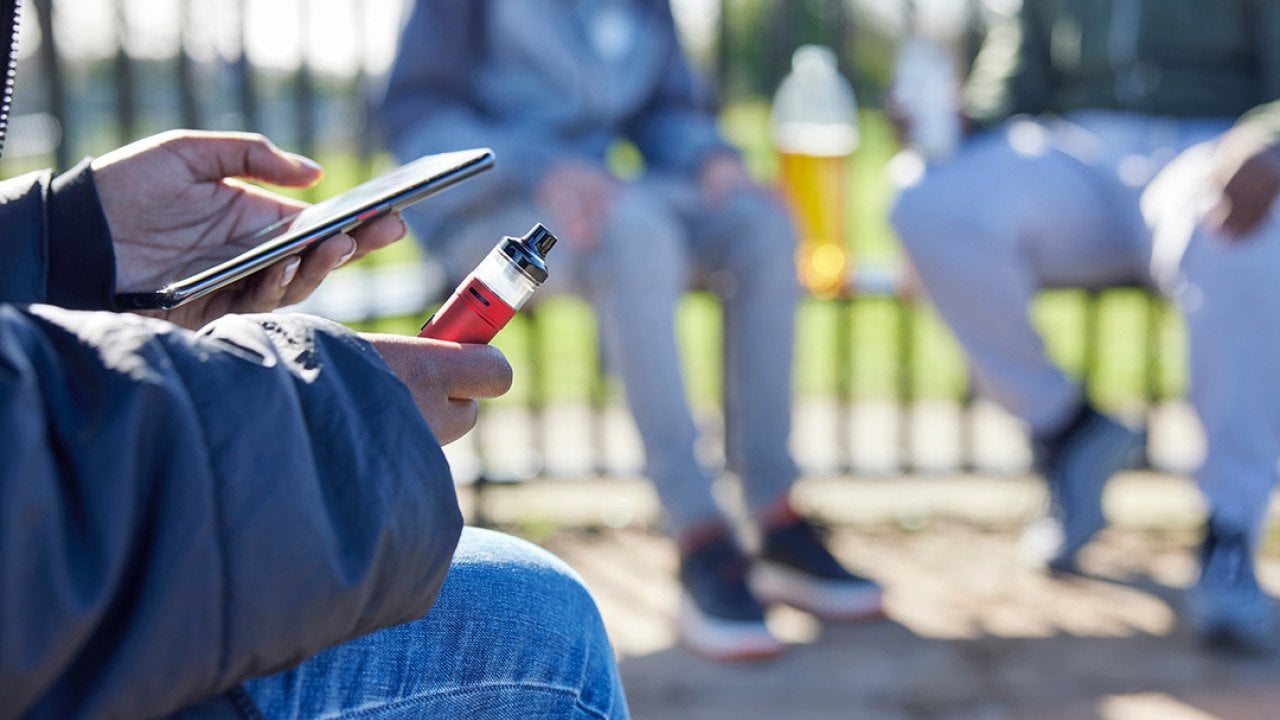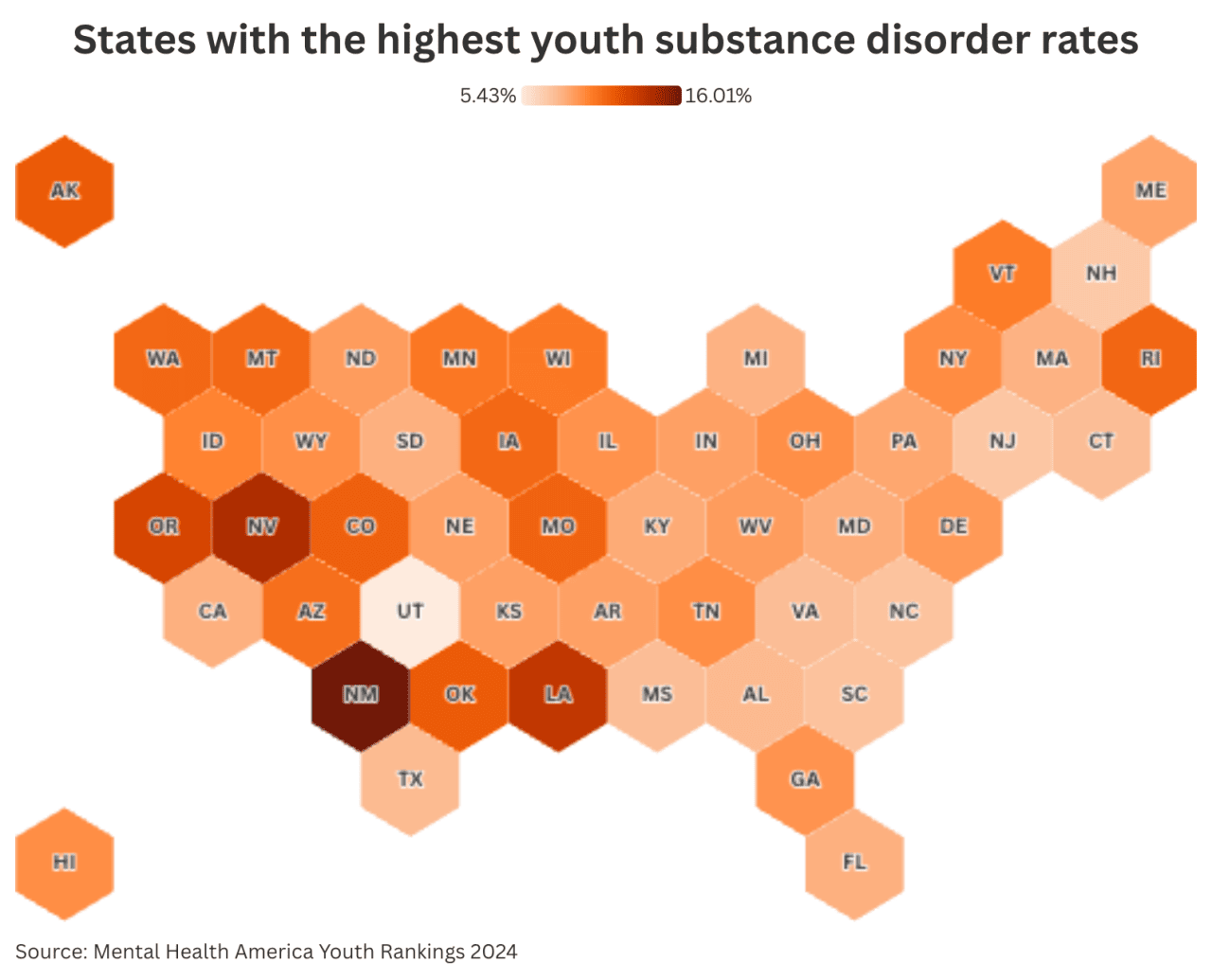Which states have the most teens struggling with substance misuse?

Daisy Daisy // Shutterstock
Which states have the most teens struggling with substance misuse?
Teen drug and alcohol use is still a serious issue across the U.S. In 2022, 1 in 3 high school seniors, 1 in 5 sophomores, and 1 in 10 eighth graders reported using illegal substances, according to the National Institute on Drug Abuse. Those numbers are lower than they were before the pandemic, but they’re still high, and the long-term impact of early substance use can follow teens well into adulthood.
It’s often understated how much location matters. Certain states see far more teens dealing with substance use disorders relative to others. That gap may come down to differences in healthcare access, local drug trends, education, and economic factors.
In this article, National Health Ratings pulls from 2024 Mental Health America data to rank every U.S. state by the percentage of teens (ages 12-17) reporting substance use problems, spotlighting where the issue is most concentrated and where support efforts may need to grow.
National trends: What the numbers show
In 2024, about 8.95% of U.S. teens, ages 12-17, had a substance use disorder. That’s around 2.3 million adolescents struggling with drugs or alcohol.
Teen drug use has stayed below pre-pandemic levels for four years in a row. But the danger hasn’t subsided; it’s only gotten worse due to the recent presence of fentanyl in counterfeit pills. Even with fewer teens using, the risk of overdose has climbed. In a study published in a 2024 issue of the New England Journal of Medicine, researchers found that on average, 22 teens die each week from overdoses.
Rural teens face even steeper challenges. A study examining 2011 and 2012 National Survey on Drug Use and Health data and published in the Journal of Rural Health found rural adolescents were about 35% more likely to misuse prescription opioids than their urban, large city peers, highlighting the need for prevention strategies that fit local realities.
Which states have the highest and lowest teen substance use rates?
Data from Mental Health America shows wide differences in teen substance use disorder (SUD) across states in 2024. New Mexico tops the list, with 16.01% of teens reporting an SUD. Nevada (14.09%), Louisiana (13.4%), Oregon (12.52%), and Alaska (11.51%) follow close behind.
At the other end, Utah reports the lowest teen SUD rate at 5.43%. New Hampshire (7.13%), New Jersey (7.25%), North Carolina (7.42%), and South Carolina (7.44%) round out the five lowest.

National Health Ratings
A clear pattern appears in the Mountain West and parts of the South, where rates tend to run higher. Rural isolation, limited access to care, and economic stress all play a role. In places like New Mexico and Alaska, teens often face gaps in healthcare and higher rates of school or job disconnection, both key risk factors for substance misuse.
The heat map above gives a state-by-state view, with darker colors showing higher rates. It’s a quick way to spot where the problem is most concentrated and where targeted action is needed most.
What drives the differences between states?
Behind the state-by-state numbers are deeper, region-specific issues. Socioeconomic stress plays a big role. States with higher teen substance use often struggle with poverty, job loss, and lower education levels — conditions that make teens more vulnerable, especially in places without strong youth support systems.
Access to care is another big reason. Many rural or underserved areas simply don’t have enough mental health providers. Even when services exist, cost, distance, or insurance gaps can keep teens from getting the help they need.
Culture and environment matter, too. In some communities, substance use is either normalized or kept quiet, making it harder for teens to spot red flags or ask for help. Local attitudes, peer substance use, and how easy it is to get drugs like opioids or cannabis can all raise the risk.
And then there’s policy. A study published in the Journal of Consulting and Clinical Psychology in 2019 found that states that invest in youth treatment and enforce strong mental health laws tend to see better outcomes. Where policy lags, so do prevention programs and access to care, widening the gap between states with rising problems and those with stronger support systems.
Why getting treatment is still so hard for teens
Even when teens know they need help, getting it is another story. Nationwide, only about 1 in 3 adolescents who need substance use treatment actually receive it, according to a study published in a 2020 issue of the journal Pediatrics. Most don’t. A big reason? Insurance and cost. Mental Health America data shows roughly 1 in 10 teens with private insurance lack mental health coverage, so care ends up out-of-network, unaffordable, or both.
Location can make things worse. Only seven states offer youth-specific treatment centers that take Medicaid and offer same-day access to evidence-based care. In most states, teens might wait weeks or drive hours just to get a spot, if they can get in at all.
The kind of facility matters, too. Nonprofits usually offer more complete care and lower costs, but waitlists can stretch for months. For-profit centers may admit teens faster, but often charge more and aren’t always set up for youth-specific needs.
The result? Too many teens fall through the cracks, either because treatment doesn’t exist near them, costs too much, or takes too long to access. Fixing those gaps is essential if we want to make real progress on teen substance use.
How to prevent teen substance use before it starts
The best way to reduce teen substance use? Start early, long before treatment is needed. Programs like Life Skills Training have a strong track record. They teach kids how to make smart choices, manage emotions, and handle peer pressure. When delivered consistently in schools, these kinds of evidence-based programs can cut the risk of substance use.
But schools can’t do it alone. The most effective prevention efforts pull in families, teachers, healthcare providers, and community leaders. When support shows up in everyday places, like after-school programs, youth groups, or school counseling, it’s more likely to reach teens before trouble starts.
That’s where early intervention matters. The sooner a problem gets spotted, the better the outcome. Screenings during school checkups or pediatric visits can help catch early warning signs before they spiral into something more serious.
Treatment is crucial, but prevention is the first and most powerful line of defense. Scaling these tools, especially in high-risk areas, could be a game changer.
Closing the gap on teen substance use
Teen substance use disorder rates vary widely by state, driven by differences in healthcare, economics, and geography. New Mexico and Nevada top the charts, while states like Utah and New Jersey stay well below the national average. These gaps make one thing clear: High-risk areas need more targeted support, and access to treatment has to improve everywhere.
Tracking these trends will only grow more important as drug risks shift, especially with fentanyl and other emerging substances in play. The best approach starts with prevention, continues with early intervention, and ends with accessible, evidence-based treatment.
With the right investment tactics, early and often, communities can move the needle. What’s now a crisis can become a turning point, helping more teens grow up healthy, supported, and resilient.
This story was produced by National Health Ratings and reviewed and distributed by Stacker.
![]()



